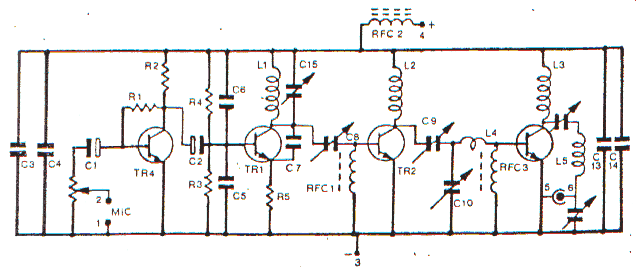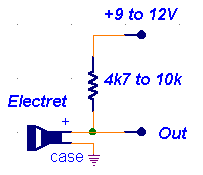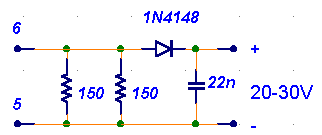
4W FM TRANSMITTER


| R1 | 220k |
| R2 | 4k7 |
| R3, R4 | 10k |
| R5 | 82 |
| VR1 | 22k log |
| C1, C2 | 4.7u/25V |
| C3, C13 | 4.7n |
| C4, C14 | 1n |
| C5, C6 | 470p |
| C7 | 10p |
| C8 | 3-10p trimmer |
| C9, C12 | 7-35p trimmer |
| C10, C11 | 20-60p trimmer |
| C15 | 4-20p trimmer |
| L1 | 4 turns, air core, 5.5mm inside diameter |
| L2 | 6 turns, air core, 5.5mm inside diameter |
| L3 | 3 turns, air core, 5.5mm inside diameter |
| L4 | etched on PCB |
| L5 | 5 turns, air core, 7.5mm inside diameter |
| RFC1, RFC2, RFC3 | VK200 (ferrite bead with 6 holes) |
| TR1, TR2 | 2N2219 |
| TR3 | 2N3553 or 2N3924 or BFS22A |
| TR4 | BC547 or BC548 |
Original source:
I found this circuit in an Italian radioamateur magazine "MegaHertz", November '96. Much later, I also spotted the same schematics at Electronics 2000
Description:
Don't be fooled by the relative simplicity of this transmitter. With 4W of power, it's not a toy! Since it operates in the FM band (88-108MHz), a licence is required for broadcasting. With a good and properly mounted antenna this baby has a range of up to 50km. In mountainous terrain or in built-up areas, this figure is smaller, of course.
The circuit is fairly small. The last two transistors dissipate quite a lot of heat. Make sure to protect them with sufficiently large heatsinks or else you'll have a nasty meltdown. The coils are not all that critical, but should still be winded carefully to ensure efficient operation. Use enamel-coated wire at least 1mm thick. As with all RF circuits, work slowly and pay attention to details.
At the input you can use a microphone (an electret one will need its own power supply as shown here:)

A better and far more professional solution, though, is to make a small mixer. Mine has two inputs: one for a dynamic microphone and the other one for direct audio from a CD-player or a tape recorder. I also added a LM386-based headphone amplifier to the mixer stage to hear what I'm transmitting, but this is an optional feature. Place the circuit in a grounded metal box. You'll also need the right antenna for this transmitter. Connect it to the via some length of 50 Ohm coaxial cable.
When you're complete, you'll have to align the circuit for maximum output power. Tune By far the best way to do that is with an SWR or a field-strength meter. There is even another alternative, somewhat less correct, but still adequate. Build this little circuit below and connect it to the points marked 5 and 6. At the output, you should get about 20 to 30V if the transmitter is aligned properly. Tune it until you get the highest reading.

Problems:
First of all, the box MUST be grounded to shield the circuit from outside noise. To power it, you could use batteries, but a mains power supply is probably more practical in many cases. If you want to have the power supply in the same box as the transmitter, however, keep in mind that the transformer should not be placed too close to the circuit. In addition, you should separate box into two compartments with a grounded metal plate between them, one compartment being for the power supply and the other for everything else.
Possible uses:
Pirate radio, of course. I should warn you that it's illegal and you'll get fined if caught. Or it would make a great backup emergency transmitter that could possibly save your life if something goes badly wrong (earthquake, floods, war). Otherwise, this circuit is intended for educational purposes only.